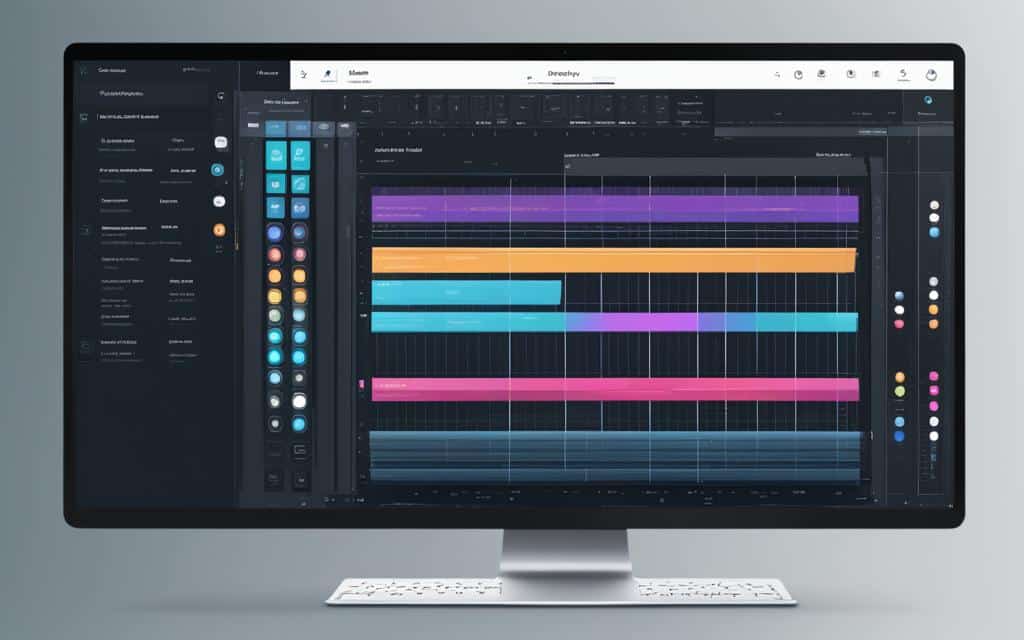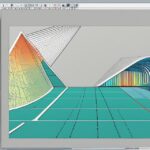Table of Contents
Choosing the right design software is crucial for graphic designers to enhance their efficiency, creativity, and the quality of their work. When selecting professional design software, there are several key features that designers should look for. These features will help them make informed decisions and choose software that meets their specific needs and goals.
Firstly, understanding your specific needs and goals is essential. By defining the type of projects you work on, such as web design, print design, illustrations, or branding, you can narrow down your choices and find software that aligns with your project requirements.
Researching and identifying industry-standard software is also important. Software options like Adobe Creative Suite (Photoshop, Illustrator, InDesign), Sketch, Figma, and CorelDRAW have become industry standards due to their extensive features, user-friendly interfaces, and wide adoption among professionals.
Assessing the ease of use and learning curve of the software is crucial. Look for a user-friendly interface, intuitive tools, and helpful documentation and tutorials to ensure a smoother learning process.
Evaluating the features and tools offered by the software is another key consideration. Compare different software options to ensure they provide vector tools, image editing capabilities, typography options, color management, and layering capabilities that meet your specific project requirements.
Checking community and support is important as well. Opt for software that has an active user community, as it can provide valuable support, inspiration, and resources.
Don’t forget to trial and test different options before making a final decision. This will allow you to experience the software firsthand and determine if it fits well with your workflow.
Lastly, consider your budget constraints and scalability. Choose software that aligns with your budget and can grow with your increasing design needs.
By considering these key features, you can ensure that you choose the best professional design software to support your creative workflow and achieve outstanding results.
Understand Your Needs and Goals
Graphic designers should start by understanding their specific needs and goals. This involves defining the type of projects they work on, such as web design, print design, illustrations, or branding. They should also consider their level of expertise and whether they need software for collaboration or working individually.
By understanding their needs and goals, designers can narrow down their choices and find software that aligns with their project requirements.
Defining Project Requirements
Before diving into the vast array of design software options available, it is crucial for graphic designers to have a clear understanding of their project requirements.
- Graphic Design Needs: Determine the specific tasks and activities involved in your graphic design projects. Consider aspects such as image editing, vector graphics, typography, layout design, and color management.
- Collaboration Software: Assess whether you will be working individually or as part of a team. If collaboration is essential, identify software that includes features for file sharing, real-time editing, and version control.
- Project Scale: Take into account the size and complexity of your projects. Some software may be better suited for small-scale projects, while others are designed for complex, enterprise-level tasks.
- Budget Constraints: Consider your budget limitations and explore software options that offer a balance between cost-effectiveness and necessary features.
Aligning Software with Goals
Once you have a clear understanding of your design needs and project requirements, you can align your goals with the features and capabilities offered by different software options:
- Efficiency and Productivity: Look for software that streamlines your design workflow and offers time-saving features such as templates, keyboard shortcuts, and automation tools.
- Specific Functionality: Identify software that specializes in the type of design work you do or the industries you serve. For example, if you primarily work on web design projects, software with advanced HTML and CSS editing capabilities may be beneficial.
- Growth and Learning: Consider software that offers room for growth and learning. Look for features that allow you to expand your skillset, experiment with new techniques, and stay up-to-date with industry trends.
- User-Friendly Interface: Evaluate the intuitiveness and ease of use of different software options. A user-friendly interface can enhance your efficiency and make the learning curve smoother.
By understanding your needs and goals, you can find design software that not only meets your project requirements but also empowers you to unleash your creativity and achieve exceptional results in your graphic design endeavors.
Research and Identify Industry Standard Software
When selecting professional design software, it is crucial for graphic designers to research and identify industry-standard software. By choosing software that has become widely accepted within the graphic design industry, designers can ensure compatibility, access a supportive community, and stay up-to-date with the latest advancements.
Industry-standard software options are renowned for their extensive features, user-friendly interfaces, and wide adoption among professionals. Some examples of industry-standard software include:
- Adobe Creative Suite: Consisting of popular applications like Photoshop, Illustrator, and InDesign, Adobe Creative Suite has long been recognized as a leading choice for graphic designers. Its robust features and versatile capabilities make it an indispensable tool for a range of design projects.
- Sketch: Lauded for its intuitive interface and focus on user experience design, Sketch is particularly favored by web and app designers. It offers powerful vector editing tools, an extensive plugin ecosystem, and collaborative features that streamline design workflows.
- Figma: As a cloud-based design tool, Figma enables seamless collaboration and real-time editing. Its powerful prototyping capabilities, design system features, and cross-platform compatibility make it a valuable choice for teams working on design projects.
- CorelDRAW: Known for its comprehensive set of vector editing tools and versatile design features, CorelDRAW is a popular choice for both illustrators and graphic designers. It has a long-standing reputation in the industry and continues to be a reliable software option for various design needs.
By selecting industry-standard software like Adobe Creative Suite, Sketch, Figma, or CorelDRAW, graphic designers can ensure that they are using tools that are trusted and widely utilized by professionals. This not only provides a sense of confidence and reliability but also facilitates easier collaboration with clients and colleagues.
Assess Ease of Use and Learning Curve
When selecting design software, graphic designers should carefully assess the ease of use and learning curve associated with the options they are considering. It is essential to choose software that aligns with their current skill level and offers a reasonable learning curve for future growth.
A user-friendly interface plays a key role in software usability. Designers should look for software that provides an intuitive and user-friendly interface, making it easier to navigate and utilize the various tools and features effectively. An interface that is cluttered or overly complex can hinder productivity and impede the creative process, so simplicity and intuitiveness are crucial.
Additionally, having access to helpful documentation and tutorials can significantly impact the learning process. Designers should prioritize software that offers comprehensive resources, such as user guides, tutorials, and online forums, where they can find answers to their questions and learn new techniques. This availability of support can facilitate skill development and enhance usability.
“Software usability is crucial for graphic designers as it directly affects their efficiency and workflow. By choosing software with a user-friendly interface and adequate learning resources, designers can optimize their output and unleash their creative potential.”
Consider Your Level of Familiarity
When assessing the ease of use and learning curve, designers should also take into account their own familiarity with design software. If they are already proficient in a particular software or have experience with similar tools, they may find it easier to adapt to a similar interface. Leveraging their existing knowledge and skills can expedite the learning process and minimize the disruption to their workflow.
On the other hand, if designers are relatively new to graphic design software or have limited experience, they should prioritize software that offers a gradual learning curve. Starting with software that is more intuitive and beginner-friendly can build confidence and help them develop a solid foundation in design principles and techniques.
Choose a Software with a User-Friendly Interface
A user-friendly interface can significantly improve the overall experience of working with design software. It allows designers to focus on their creative process rather than struggling with complex menus and toolsets. When evaluating software options, designers should prioritize those that offer a clean and intuitive interface, enabling seamless navigation and efficient use of tools.
The interface should present the tools and features in an organized and logical manner, making it easy for designers to locate and utilize them. Additionally, customizable workspaces and keyboard shortcuts can further enhance usability, enabling designers to create a personalized workflow that suits their preferences.
In conclusion, the ease of use and learning curve are critical factors to consider when choosing design software. Prioritizing user-friendly interfaces, intuitive tools, and comprehensive learning resources can enhance the user experience and facilitate skill development. By selecting software that aligns with their familiarity and offers a smooth learning curve, graphic designers can optimize their workflow and unlock their creative potential.
Evaluate Features and Tools
When selecting professional design software, it’s essential to thoroughly evaluate the features and tools offered by different options. Designers should compare these aspects to ensure they meet their specific project requirements and enable them to bring their creative vision to life.
One of the key aspects to consider is the availability and functionality of vector tools. These tools allow designers to create and manipulate scalable graphics with precision. By having access to a robust set of vector tools, designers can easily create logos, icons, and illustrations without compromising quality.
Image editing capabilities are another vital feature to assess. Design software should provide advanced image editing tools that enable designers to enhance, retouch, and manipulate their visuals. These capabilities empower designers to perfect every pixel and create visually stunning designs.
The software’s typography options also play a significant role in the design process. Designers need access to a wide range of fonts, as well as complete control over typography settings such as kerning, leading, and tracking. Typography can greatly impact the overall look and feel of a design, so having robust typography options is crucial.
Color management is another important consideration. The software should offer features that allow designers to work with colors accurately, including color picking, palettes, and color schemes. This ensures consistency in color representation across different devices and printing mediums.
Layering capabilities are crucial for managing complex design projects. The software should offer a robust layering system that allows designers to organize elements, adjust their stacking order, and apply effects to individual layers. This enables designers to work efficiently and non-destructively, making it easier to iterate and make changes to their designs.
Having a comprehensive evaluation of the features and tools offered is essential to ensure that the selected software meets all the necessary requirements for successful design projects.
| Features | Description |
|---|---|
| Vector Tools | Enable precise creation and manipulation of scalable graphics. |
| Image Editing Capabilities | Advanced tools for enhancing, retouching, and manipulating visuals. |
| Typography Options | Wide range of fonts and complete control over typography settings. |
| Color Management | Tools for accurate color representation and management. |
| Layering Capabilities | Flexible and efficient layering system for managing complex designs. |
By thoroughly evaluating the features and tools offered by different design software options, designers can make an informed decision that aligns with their specific project requirements and enables them to achieve their desired design outcomes.
Conclusion
In summary, selecting the right professional design software is an essential decision for graphic designers. By understanding their specific needs and goals, researching industry-standard software, considering ease of use and the learning curve, evaluating features and tools, checking community and support, and testing different options, designers can make an informed choice. It is crucial to prioritize software that aligns with their budget, growth, and evolving industry standards. Ultimately, by choosing the best design software, graphic designers can elevate their creativity, productivity, and overall efficiency in their design workflow.
FAQ
What are the key features to look for in professional design software?
The key features to look for in professional design software include understanding specific needs and goals, researching and identifying industry-standard software, considering platform compatibility, assessing ease of use and the learning curve, evaluating features and tools, checking community and support, trial and testing, considering budget constraints and scalability, reading reviews and getting recommendations, considering alternative and specialized software, and staying updated on new updates and advancements in the field.
How do I understand my needs and goals for design software?
To understand your needs and goals for design software, you should define the type of projects you work on, such as web design, print design, illustrations, or branding. Consider your level of expertise and whether you need software for collaboration or working individually. By understanding your needs and goals, you can narrow down your choices and find software that aligns with your project requirements.
What are some examples of industry-standard design software?
Some examples of widely accepted industry-standard design software include Adobe Creative Suite (Photoshop, Illustrator, InDesign), Sketch, Figma, and CorelDRAW. These software options have become industry standards due to their extensive features, user-friendly interfaces, and wide adoption among professionals.
How can I assess the ease of use and learning curve of design software?
You can assess the ease of use and learning curve of design software by considering its user-friendly interface, intuitive tools, and helpful documentation and tutorials. It is important to choose software that aligns with your current skill level and offers a reasonable learning curve for further growth.
What features and tools should I evaluate when selecting design software?
When selecting design software, you should evaluate features and tools such as vector tools, image editing capabilities, typography options, color management, and layering capabilities. Each designer may have different priorities and preferences, so it is important to thoroughly evaluate these aspects before making a decision.













